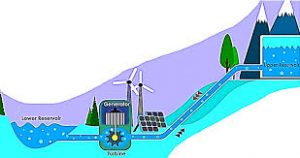Pumped Storage Hydropower:

Budget 2024-25 promised that “a policy for promoting pumped storage projects will be brought out for electricity storage.
- Pumped Storage Hydropower (PSH) is a type of hydroelectric energy storage.
- It is a fundamentally simple system that consists of two water reservoirs at different elevations.
- When there is excess electricity available, such as during off-peak hours or from renewable sources like solar and wind, it is used to pump water from the lower reservoir to the upper reservoir.
- When there is a demand for electricity, the water is released from the upper reservoir back down to the lower reservoir, passing through turbines that generate electricity.
- The system also requires power as it pumps water back into the upper reservoir (recharge).
- PSH plants operate much like conventional hydropower plants, except PSH has the ability to use the same water over and over again.
- The technology absorbs surplus energy at times of low demand and releases it when demand is high.
- The energy storage capacity of a PSH depends on the size of its two reservoirs, while the amount of power generated is linked to the size of the turbine.
- There are two main types of PSH:
- Open-loop:with either an upper or lower reservoir that is continuously connected to a naturally flowing water source such as a river.
- Closed-loop:an ‘off-river’ site that produces power from water pumped to an upper reservoir without a significant natural inflow.




